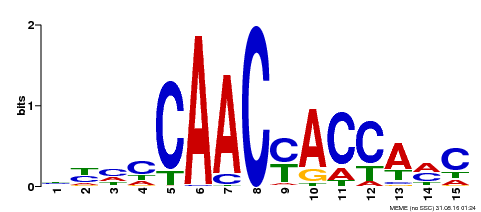- Daniel X,Lacomme C,Morel JB,Roby D
A novel myb oncogene homologue in Arabidopsis thaliana related to hypersensitive cell death.
Plant J., 1999. 20(1): p. 57-66
[PMID:10571865] - Kleinow T, et al.
Functional identification of an Arabidopsis snf4 ortholog by screening for heterologous multicopy suppressors of snf4 deficiency in yeast.
Plant J., 2000. 23(1): p. 115-22
[PMID:10929106] - Riechmann JL, et al.
Arabidopsis transcription factors: genome-wide comparative analysis among eukaryotes.
Science, 2000. 290(5499): p. 2105-10
[PMID:11118137] - Stracke R,Werber M,Weisshaar B
The R2R3-MYB gene family in Arabidopsis thaliana.
Curr. Opin. Plant Biol., 2001. 4(5): p. 447-56
[PMID:11597504] - Vailleau F, et al.
A R2R3-MYB gene, AtMYB30, acts as a positive regulator of the hypersensitive cell death program in plants in response to pathogen attack.
Proc. Natl. Acad. Sci. U.S.A., 2002. 99(15): p. 10179-84
[PMID:12119395] - Yamada K, et al.
Empirical analysis of transcriptional activity in the Arabidopsis genome.
Science, 2003. 302(5646): p. 842-6
[PMID:14593172] - Yanhui C, et al.
The MYB transcription factor superfamily of Arabidopsis: expression analysis and phylogenetic comparison with the rice MYB family.
Plant Mol. Biol., 2006. 60(1): p. 107-24
[PMID:16463103] - Raffaele S,Rivas S,Roby D
An essential role for salicylic acid in AtMYB30-mediated control of the hypersensitive cell death program in Arabidopsis.
FEBS Lett., 2006. 580(14): p. 3498-504
[PMID:16730712] - Raffaele S, et al.
A MYB transcription factor regulates very-long-chain fatty acid biosynthesis for activation of the hypersensitive cell death response in Arabidopsis.
Plant Cell, 2008. 20(3): p. 752-67
[PMID:18326828] - Li L, et al.
Arabidopsis MYB30 is a direct target of BES1 and cooperates with BES1 to regulate brassinosteroid-induced gene expression.
Plant J., 2009. 58(2): p. 275-86
[PMID:19170933] - Okada S, et al.
Reconstitution of Arabidopsis thaliana SUMO pathways in E. coli: functional evaluation of SUMO machinery proteins and mapping of SUMOylation sites by mass spectrometry.
Plant Cell Physiol., 2009. 50(6): p. 1049-61
[PMID:19376783] - Reina-Pinto JJ, et al.
Misexpression of FATTY ACID ELONGATION1 in the Arabidopsis epidermis induces cell death and suggests a critical role for phospholipase A2 in this process.
Plant Cell, 2009. 21(4): p. 1252-72
[PMID:19376931] - Froidure S,Roby D,Rivas S
Expression of the Arabidopsis transcription factor AtMYB30 is post-transcriptionally regulated.
Plant Physiol. Biochem., 2010. 48(8): p. 735-9
[PMID:20605724] - Froidure S, et al.
AtsPLA2-alpha nuclear relocalization by the Arabidopsis transcription factor AtMYB30 leads to repression of the plant defense response.
Proc. Natl. Acad. Sci. U.S.A., 2010. 107(34): p. 15281-6
[PMID:20696912] - Arabidopsis Interactome Mapping Consortium
Evidence for network evolution in an Arabidopsis interactome map.
Science, 2011. 333(6042): p. 601-7
[PMID:21798944] - Canonne J, et al.
The Xanthomonas type III effector XopD targets the Arabidopsis transcription factor MYB30 to suppress plant defense.
Plant Cell, 2011. 23(9): p. 3498-511
[PMID:21917550] - Bruex A, et al.
A gene regulatory network for root epidermis cell differentiation in Arabidopsis.
PLoS Genet., 2012. 8(1): p. e1002446
[PMID:22253603] - Canonne J, et al.
Identification of the protein sequence of the type III effector XopD from the B100 strain of Xanthomonas campestris pv campestris.
Plant Signal Behav, 2012. 7(2): p. 184-7
[PMID:22353870] - Zheng Y,Schumaker KS,Guo Y
Sumoylation of transcription factor MYB30 by the small ubiquitin-like modifier E3 ligase SIZ1 mediates abscisic acid response in Arabidopsis thaliana.
Proc. Natl. Acad. Sci. U.S.A., 2012. 109(31): p. 12822-7
[PMID:22814374] - Marino D, et al.
Arabidopsis ubiquitin ligase MIEL1 mediates degradation of the transcription factor MYB30 weakening plant defence.
Nat Commun, 2013. 4: p. 1476
[PMID:23403577] - Li-Beisson Y, et al.
Acyl-lipid metabolism.
Arabidopsis Book, 2013. 11: p. e0161
[PMID:23505340] - Raffaele S,Rivas S
Regulate and be regulated: integration of defense and other signals by the AtMYB30 transcription factor.
Front Plant Sci, 2013. 4: p. 98
[PMID:23596456] - Ding Y, et al.
Four distinct types of dehydration stress memory genes in Arabidopsis thaliana.
BMC Plant Biol., 2013. 13: p. 229
[PMID:24377444] - Tavares CP, et al.
S-nitrosylation influences the structure and DNA binding activity of AtMYB30 transcription factor from Arabidopsis thaliana.
Biochim. Biophys. Acta, 2014. 1844(4): p. 810-7
[PMID:24583075] - Liu L, et al.
Elevated levels of MYB30 in the phloem accelerate flowering in Arabidopsis through the regulation of FLOWERING LOCUS T.
PLoS ONE, 2014. 9(2): p. e89799
[PMID:24587042] - Xie LJ, et al.
Arabidopsis acyl-CoA-binding protein ACBP3 participates in plant response to hypoxia by modulating very-long-chain fatty acid metabolism.
Plant J., 2015. 81(1): p. 53-67
[PMID:25284079] - Jin J, et al.
An Arabidopsis Transcriptional Regulatory Map Reveals Distinct Functional and Evolutionary Features of Novel Transcription Factors.
Mol. Biol. Evol., 2015. 32(7): p. 1767-73
[PMID:25750178] - Kaurilind E,Xu E,Brosché M
A genetic framework for H2O2 induced cell death in Arabidopsis thaliana.
BMC Genomics, 2015. 16: p. 837
[PMID:26493993] - Lee HG,Seo PJ
The Arabidopsis MIEL1 E3 ligase negatively regulates ABA signalling by promoting protein turnover of MYB96.
Nat Commun, 2016. 7: p. 12525
[PMID:27615387] - Serrano I, et al.
A non canonical subtilase attenuates the transcriptional activation of defence responses in Arabidopsis thaliana.
Elife, 2017.
[PMID:27685353] - Liao C,Zheng Y,Guo Y
MYB30 transcription factor regulates oxidative and heat stress responses through ANNEXIN-mediated cytosolic calcium signaling in Arabidopsis.
New Phytol., 2017. 216(1): p. 163-177
[PMID:28726305] - Lee HG,Kim J,Suh MC,Seo PJ
The MIEL1 E3 Ubiquitin Ligase Negatively Regulates Cuticular Wax Biosynthesis in Arabidopsis Stems.
Plant Cell Physiol., 2017. 58(7): p. 1249-1259
[PMID:28838126] - Mabuchi K, et al.
MYB30 links ROS signaling, root cell elongation, and plant immune responses.
Proc. Natl. Acad. Sci. U.S.A., 2018. 115(20): p. E4710-E4719
[PMID:29712840] - Zheng Y,Chen Z,Ma L,Liao C
The Ubiquitin E3 Ligase RHA2b Promotes Degradation of MYB30 in Abscisic Acid Signaling.
Plant Physiol., 2018. 178(1): p. 428-440
[PMID:30030326]
|





